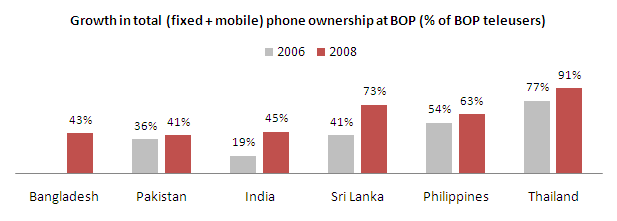Just five years ago, the Indian telecom industry’s massive momentum barely included the poor. The country had slightly over seven access paths (fixed and mobile connections) per 100 people, but in rural India 100 people were served by only 1.5 access paths. Even in urban India, the poor were unconnected.
But now, the picture is different. Last October, Minister A. Raja stated that there were 11 access paths per 100 rural inhabitants, compared to 30 for urbanites. Massive progress has been achieved, but is it making an impact at the bottom of the pyramid (BOP)?
LIRNEasia’s Teleuse@BOP3 study has yielded some intriguing answers.
Forty five percent of Indian BOP teleuser households had a phone in late 2008. Thirty seven percent had a mobile only; five percent had a fixed phone only; three percent had both. This is massive progress from the 19 percent of BOP homes with a phone just two years ago.
In 2006, public phones of various kinds were the most frequently used; of the BOP teleusers, 71 percent relied on them. By 2008, 36 percent said “my own mobile” was the most frequently used mode, over the 33 percent using public phones.
The most recent quantitative findings of the Teleuse@BOP3 study are now available. The findings were released at a presentation to the Cellular Operators Association of India in February 2009. The study looks at teleuse at the ‘bottom of the pyramid,’ or the lowest socio-economic classes across six Asian countries: Bangladesh, India, Pakistan, the Philippines, Sri Lanka, and Thailand. The quantitative component involved a detailed face-to-face survey of 9,750 sample representative of the BOP in the six countries.
Though across all six countries it appears that the access challenge has been met, there is still huge potential for more‐than voice services. Awareness levels are still low and usage even lower. Download findings to see more.





1 Comment
Karen Cayamanda
At least now more and more people are using mobile phones in their everyday lives.